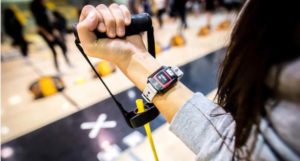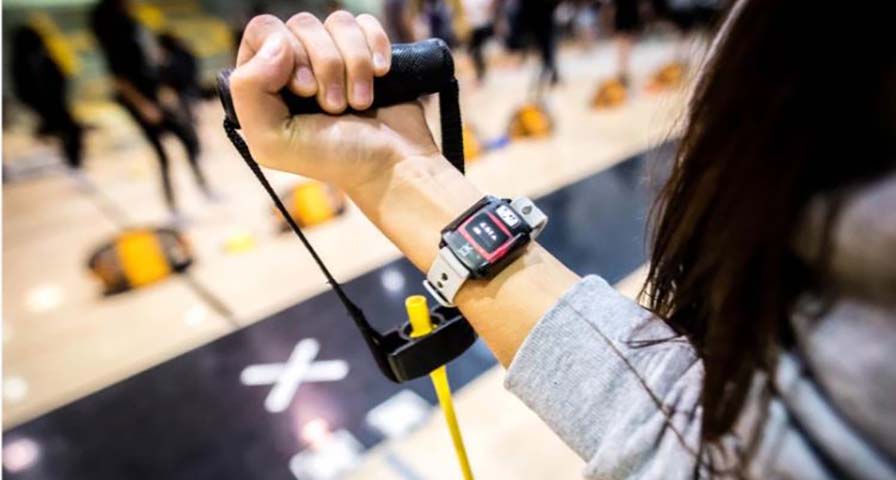Originally published Nov. 22, 2019 in The Sun.
By Brian Whitehead
As uptempo music blares inside Arroyo Valley High’s gymnasium, Scott Smith weaves through lines of underclassmen doing push ups, jumping jacks and other cardiovascular exercises at separate stations.
On occasion, the 54-year-old physical education teacher joins in, shouting words of encouragement between deep breaths.

Student Laura Urieta, 15, exercises with resistance bands while wearing a wristband heart rate monitor during physical education class at Arroyo Valley High gymnasium in San Bernardino on Thursday, Nov. 21, 2019. Students wear heart rate monitors during PE to track their activity. (Photo by Watchara Phomicinda, The Press-Enterprise/SCNG)
Every 45 seconds, the music stops and all 84 students glance at their wrist before rotating to the next set.
A few beats later, the gymnasium is rocking again.
A longtime teacher with San Bernardino City Unified, Smith’s PE class is not like most.
And that, he said, is the problem.
Last year, the school district awarded Smith an innovation grant to purchase dozens of wrist-worn heart rate monitors for a pilot program allowing students to track their pulse before, during and after a day’s activity.
The reaction was so overwhelmingly positive, Smith said, that this year nearly 700 kids at Arroyo Valley are using the interactive technology.
“We’ve seen a huge impact on how students are now approaching PE classes,” said Smith, a longtime coach in the district. “They’re excited to see their own numbers. They’re motivating themselves, becoming self-determined students, and the intensity level has increased.
“It’s really leveled the playing field for all students,” he said. “They’re no longer being graded against somebody else. They’re being graded against themselves.”
About five years ago, as he noticed participation and enthusiasm for his class waning, he drew up a program allowing students to choose whether to do a traditional sport, non-traditional sport or fitness activity that day.
Engagement spiked as a result, he said.
To further promote physical, cognitive, social and mental health, Smith piloted the heart rate monitors last year and was able to provide students real-time fitness assessments at the end of class – a boon, he said, for teens previously prone to inactivity between bells.
What’s more, Smith said, is he could send fitness reports and wellness plans home with students to help them foster healthy habits away from campus.
“PE hasn’t changed since when I went to school,” said Smith, a Pacific High alum and former San Bernardino County Athlete of the Year. “You play basketball, football, soccer, all these sports. But what we found out is there might be kids who don’t like sports, don’t like competition, so they just weren’t engaged. They showed no interest.
“Since we’ve added choices and the heart rate monitors, a ridiculous 99% of kids come to class knowing they’re willing to participate and be engaged.”
Gabriella Trevino, a junior at Arroyo Valley, and sophomore Emmanuel Vallejo are two of Smith’s PE students and testaments to how valuable the teacher’s program is to teens.
Trevino said she has battled depression for three years and at first, didn’t see how wearing a heart rate monitor on her wrist while exercising during PE would help.
But she gave it a shot.
This week, Trevino said the progress she made in Smith’s class last year lifted her spirits and motivated her to stay active. Some of the exercises help her get out of moods at home, she said.
“The more you try and the more you get into it, the better you’re going to be,” she added. “If you’re really into it, you just can’t give up on it.”
Vallejo, meanwhile, was diagnosed with diabetes this year.
Thanks, in part, to Smith’s PE class and the routines from it he has taken home, Vallejo’s blood sugar level has dropped considerably since his diagnosis and he is down a few pounds, healthy and active.
“I’ve observed elementary school PE, middle school PE, high school PE, and this by far is a step above the rest,” student teacher Miguel Figueroa said. “I hate the stereotype of grabbing a ball and rolling it out and doing nothing. Recess, pretty much, at a high level.
“I always thought high school PE was the worst until I came here,” Figueroa said. “You can really work and do a lot of things with students, especially with the heart rate monitors. You can help them hold themselves accountable.”
Smith’s goal is to get heart rate monitors and innovative lesson plans into every school in the district.
In addition to bolstering participation, engagement and physical health, Smith has found that his wristwatches and revamped approach have all but eliminated behavioral issues in class.
Furthermore, he said, students are trading months of sweat equity in for passing grades.
“So many times I’ve heard that all PE does is roll out the balls,” Smith said. “That all PE does is have kids stand in the corner, that it’s the easiest class to pass. We have to rebrand ourselves. We have to send a message that we have a subject that is truly life and death.
“Isn’t that our job,” Smith said, “to change people’s lives? We’re going to change how things are perceived around here, and this is the start.”
Seeking IHT Spirit System information?




